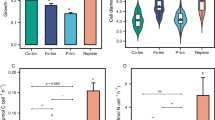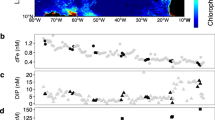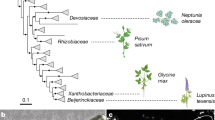Abstract
Marine dinitrogen (N2)-fixing cyanobacteria have large impacts on global biogeochemistry as they fix carbon dioxide (CO2) and fertilize oligotrophic ocean waters with new nitrogen. Iron (Fe) and phosphorus (P) are the two most important limiting nutrients for marine biological N2 fixation, and their availabilities vary between major ocean basins and regions. A long-standing question concerns the ability of two globally dominant N2-fixing cyanobacteria, unicellular Crocosphaera and filamentous Trichodesmium, to maintain relatively high N2-fixation rates in these regimes where both Fe and P are typically scarce. We show that under P-deficient conditions, cultures of these two cyanobacteria are able to grow and fix N2 faster when Fe deficient than when Fe replete. In addition, growth affinities relative to P increase while minimum concentrations of P that support growth decrease at low Fe concentrations. In Crocosphaera, this effect is accompanied by a reduction in cell sizes and elemental quotas. Relatively high growth rates of these two biogeochemically critical cyanobacteria in low-P, low-Fe environments such as those that characterize much of the oligotrophic ocean challenge the common assumption that low Fe levels can have only negative effects on marine primary producers. The closely interdependent influence of Fe and P on N2-fixing cyanobacteria suggests that even subtle shifts in their supply ratio in the past, present and future oceans could have large consequences for global carbon and nitrogen cycles.
Similar content being viewed by others
Log in or create a free account to read this content
Gain free access to this article, as well as selected content from this journal and more on nature.com
or
References
Bec B, Collos Y, Vaque A, Mouillot D, Souchu P . (2008). Growth rate peaks at intermediate cell size in marine photosynthetic picoeukaryotes. Limnol Oceanogr 53: 863–867.
Berman-Frank I, Quigg A, Finkel ZV, Irwin AJ, Haramaty L . (2007). Nitrogen-fixation strategies and Fe requirements in cyanobacteria. Limnol Oceanogr 52: 2260–2269.
Boyd PW, Newton PP . (1999). Does planktonic community structure determine downward particulate organic carbon flux in different oceanic provinces? Deep Sea Res Pt I 46: 63–91.
Capone DG, Zehr JP, Paerl HW, Bergman B, Carpenter EJ . (1997). Trichodesmium, a globally significant marine cyanobacterium. Science 276: 1221–1229.
Capone DG, Burns JA, Montoya JP, Subramaniam A, Mahaffey C, Gunderson T et al. (2005). Nitrogen fixation by Trichodesmium spp.: an important source of new nitrogen to the tropical and subtropical North Atlantic Ocean. Global Biogeochem Cy 19: GB2024.
Chen YB, Zehr JP, Mellon M . (1996). Growth and nitrogen fixation of the diazotrophic filamentous nonheterocystous cyanobacterium Trichodesmium sp IMS 101 in defined media: Evidence for a circadian rhythm. J Phycol 32: 916–923.
Falcón LI, Carpenter EJ, Cipriano F, Bergman B, Capone DG . (2004). N2 fixation by unicellular bacterioplankton from the Atlantic and Pacific Oceans: phylogeny and in situ rates. Appl Environ Microbiol 70: 765–770.
Falkowski PG . (1997). Evolution of the nitrogen cycle and its influence on the biological sequestration of CO2 in the ocean. Nature 387: 272–275.
Finkel ZV, Sebbo J, Feist-Burkhardt S, Irwin AJ, Katz ME, Schofield OME et al. (2007). A universal driver of macroevolutionary change in the size of marine phytoplankton over the Cenozoic. PNAS 104: 20416–20420.
Garcia NS, Fu F, Hutchins DA . (2013). Colimitation of the unicellular photosynthetic diazotroph Crocosphaera watsonii by phosphorus, light and carbon dioxide. Limnol Oceanogr 58: 1501–1512.
Grabowski MNW, Church MJ, Karl DM . (2008). Nitrogen fixation rates and controls at Stn ALOHA. Aquat Microb Ecol 52: 175–183.
Hutchins DA, Fu FX, Webb EA, Walworth N, Tagliabue A . (2013). Taxon-specific response of marine nitrogen fixers to elevated carbon dioxide concentrations. Nature Geosci 6: 790–795.
Jacq V, Ridame C, Helguen SL, Kaczmar F, Saliot A . (2014). Response of the unicellular diazotrophic cyanobacterium Crocosphaera watsonii to iron limitation. PLoS One 9: e86749.
Karl DM . (2014). Microbially mediated transformations of phosphorus in the sea: new views of an old cycle. Annu Rev Mar Sci 6: 279–337.
Karl DM, Tien G . (1992). Magic: a sensitive and precise method for measuring dissolved phosphorus in aquatic environments. Limnol Oceanogr 37: 105–116.
Keren N, Aurora R, Pakrasi HB . (2004). Critical roles of bacterioferritins in iron storage and proliferation of cyanobacteria. Plant Physiol 135: 1666–1673.
Litchman E, Klausmeier CA, Schofield OM, Falkowski PG . (2007). The role of functional traits and trade-offs in structuring phytoplankton communities: scaling from cellular to ecosystem level. Ecol Lett 10: 1170–1181.
Liu XW, Millero FJ . (2002). The solubility of iron in seawater. Mar Chem 77: 43–54.
Mahaffey C, Michaels AF, Capone DG . (2005). The conundrum of marine N2 fixation. Amer J Science 305: 546–595.
Mahowald NM, Engelstaedter S, Luo C, Sealy A, Artaxo P, Benitez-Nelson C et al. (2009). Atmospheric iron deposition: global distribution, variability, and human perturbations. Annu Rev Mar Sci 1: 245–278.
Marañón E, Cermeño P, López-Sandoval DC, Rodríguez-Ramos T, Sobrino C, Huete-Ortega M et al. (2013). Unimodal size scaling of phytoplankton growth and the size dependence of nutrient uptake and use. Ecol Lett 16: 371–379.
Mather RL, Reynolds SE, Wolff GA, Williams RG, Torres-Valdes S, Woodward EMS et al. (2008). Phosphorus cycling in the North and South Atlantic Ocean subtropical gyres. Nature Geosci 1: 439–443.
Michaels AF, Karl DM, Capone DG . (2001). Element stoichiometry, new production and nitrogen fixation. Oceanography 14: 68–77.
Mills MM, Ridame C, Davey M, La Roche J, Geider RJ . (2004). Iron and phosphorus co-limit nitrogen fixation in the eastern tropical North Atlantic. Nature 429: 292–294.
Moore CM, Mills MM, Achterberg EP, Geider RJ, LaRoche J, Lucas MI et al. (2009). Large-scale distribution of Atlantic nitrogen fixation controlled by iron availability. Nature Geosci 2: 867–871.
Moore CM, Mills MM, Arrigo KR, Berman-Frank I, Bopp L, Boyd PW et al. (2013). Processes and patterns of oceanic nutrient limitation. Nature Geosci 6: 701–710.
Morán XAG, López-Urrutia Á, Calvo-Díaz A, Li WKW . (2010). Increasing importance of small phytoplankton in a warmer ocean. Global Change Biol 16: 1137–1144.
Price NM, Harrison GI, Hering JG, Hudson RJ, Nirel PMV, Palenik B et al. (1989). Preparation and chemistry of the artificial algal culture medium Aquil. Biol Oceanogr 6: 443–461.
Rao NN, Gomez-Garcia MR, Kornberg A . (2009). Inorganic polyphosphate: essential for growth and survival. Annu Rev Biochem 78: 605–647.
Raven JA . (1988). The iron and molybdenum use efficiencies of plant growth with different energy, carbon and nitrogen sources. New Phytol 109: 279–287.
Raven JA . (1994). Why are there no picoplanktonic O2 evolvers with volumes less than 10-19 m3? J Plankton Res 16: 565–580.
Raven JA, Beardall J, Larkum AWD, Sanchez-Bracaldo P . (2013). Interactions of photosynthesis with genome size and function. Phil Trans Roy Soc Lond B 368: 20120224.
Saito MA, Goepfert TJ, Ritt JT . (2008). Some thoughts on the concept of colimitation: Three definitions and the importance of bioavailability. Limnol Oceanogr 53: 276–290.
Sañudo-Wilhelmy SA, Kustka AB, Gobler CJ, Hutchins DA, Yang M, Lwiza K et al. (2001). Phosphorus limitation of nitrogen fixation by Trichodesmium in the central Atlantic Ocean. Nature 411: 66–69.
Sedwick PN, Church TM, Bowie AR, Marsay CM, Ussher SJ, Achilles KM et al. (2005). Iron in the Sargasso Sea (Bermuda Atlantic Time-series Study region) during summer: Eolian imprint, spatiotemporal variability, and ecological implications. Global Biogeochem Cy 19: GB4006.
Sohm JA, Webb EA, Capone DG . (2011). Emerging patterns of marine nitrogen fixation. Nat Rev Microbiol 9: 499–508.
Sunda WG, Huntsman SA . (1995). Iron uptake and growth limitation in oceanic and coastal phytoplankton. Mar Chem 50: 189–206.
Sunda WG, Price NM, Morel FMM . (2005). Trace metal ion buffers and their use in culture studies. In Andersen RA (ed.) Algal Culturing Techniques. Elsevier Academic Press: Burlington, pp 35–63.
Sunda WG, Hardison DR . (2010). Evolutionary tradeoffs among nutrient acquisition, cell size, and grazing defense in marine phytoplankton promote ecosystem stability. Mar Ecol Prog Ser 401: 63–76.
Sarmiento JL, Slater R, Barber R, Bopp L, Doney SC, Hirst AC et al. (2004). Response of ocean ecosystems to climate warming. Global Biogeochem Cy 18: GB3003.
Wheat CG, Feely RA, Mottl MJ . (1996). Phosphate removal by oceanic hydrothermal processes: an update of the phosphorus budget in the ocean. Geochim Cosmochim Acta 60: 3593–3608.
Wu JF, Sunda W, Boyle EA, Karl DM . (2000). Phosphate depletion in the western North Atlantic Ocean. Science 289: 759–762.
Zar JH . (1999) Biostatistical analysis 4th Edn. Prentice Hall: New Jersey.
Acknowledgements
We thank Bettina Sohst, Huimin Chen for analytical help, Eric Webb for providing the isolates that we used in this study and Adam Martiny for use of his nutrient analysis facilities. Grant support was provided by the National Science Foundation (NSF) Division of Ocean Sciences (OCE) 0962309 and 1260490 to D Hutchins and F Fu.
Author information
Authors and Affiliations
Corresponding author
Ethics declarations
Competing interests
The authors declare no conflict of interest.
Additional information
Supplementary Information accompanies this paper on The ISME Journal website
Rights and permissions
About this article
Cite this article
Garcia, N., Fu, F., Sedwick, P. et al. Iron deficiency increases growth and nitrogen-fixation rates of phosphorus-deficient marine cyanobacteria. ISME J 9, 238–245 (2015). https://doi.org/10.1038/ismej.2014.104
Received:
Revised:
Accepted:
Published:
Issue date:
DOI: https://doi.org/10.1038/ismej.2014.104
This article is cited by
-
Phosphorus deficiency alleviates iron limitation in Synechocystis cyanobacteria through direct PhoB-mediated gene regulation
Nature Communications (2024)
-
Molecular mechanisms underlying iron and phosphorus co-limitation responses in the nitrogen-fixing cyanobacterium Crocosphaera
The ISME Journal (2022)
-
Everything Is Everywhere: Physiological Responses of the Mediterranean Sea and Eastern Pacific Ocean Epiphyte Cobetia Sp. to Varying Nutrient Concentration
Microbial Ecology (2022)
-
Trace metal and nitrogen concentrations differentially affect bloom forming cyanobacteria of the genus Dolichospermum
Aquatic Sciences (2021)
-
The use of genome-scale metabolic network reconstruction to predict fluxes and equilibrium composition of N-fixing versus C-fixing cells in a diazotrophic cyanobacterium, Trichodesmium erythraeum
BMC Systems Biology (2017)



